I am trying to plot flow map (for singapore) . I have Entry(Lat,Long) and Exit (Lat,long). I am trying to map the flow from entry to exit in singapore map.
structure(list(token_id = c(1.12374e+19, 1.12374e+19, 1.81313e+19,
1.85075e+19, 1.30752e+19, 1.30752e+19, 1.32828e+19, 1.70088e+19,
1.70088e+19, 1.70088e+19, 1.05536e+19, 1.44818e+19, 1.44736e+19,
1.44736e+19, 1.44736e+19, 1.44736e+19, 1.89909e+19, 1.15795e+19,
1.15795e+19, 1.15795e+19, 1.70234e+19, 1.70234e+19, 1.44062e+19,
1.21512e+19, 1.21512e+19, 1.95909e+19, 1.95909e+19, 1.50179e+19,
1.50179e+19, 1.24174e+19, 1.36445e+19, 1.98549e+19, 1.92068e+19,
1.18468e+19, 1.18468e+19, 1.92409e+19, 1.92409e+19, 1.21387e+19,
1.9162e+19, 1.9162e+19, 1.40385e+19, 1.40385e+19, 1.32996e+19,
1.32996e+19, 1.69103e+19, 1.69103e+19, 1.57387e+19, 1.40552e+19,
1.40552e+19, 1.00302e+19), Entry_Station_Lat = c(1.31509, 1.33261,
1.28425, 1.31812, 1.33858, 1.29287, 1.39692, 1.37773, 1.33858,
1.33322, 1.28179, 1.30036, 1.43697, 1.39752, 1.27637, 1.39752,
1.41747, 1.35733, 1.28405, 1.37773, 1.35898, 1.42948, 1.32774,
1.42948, 1.349, 1.36017, 1.34971, 1.38451, 1.31509, 1.31509,
1.37002, 1.34971, 1.31231, 1.39169, 1.31812, 1.44909, 1.29341,
1.41747, 1.33759, 1.44062, 1.31509, 1.38451, 1.29461, 1.32388,
1.41747, 1.27614, 1.39752, 1.39449, 1.33261, 1.31231), Entry_Station_Long = c(103.76525,
103.84718, 103.84329, 103.89308, 103.70611, 103.8526, 103.90902,
103.76339, 103.70611, 103.74217, 103.859, 103.85563, 103.7865,
103.74745, 103.84596, 103.74745, 103.83298, 103.9884, 103.85152,
103.76339, 103.75191, 103.83505, 103.67828, 103.83505, 103.74956,
103.88504, 103.87326, 103.74437, 103.76525, 103.76525, 103.84955,
103.87326, 103.83793, 103.89548, 103.89308, 103.82004, 103.78479,
103.83298, 103.69742, 103.80098, 103.76525, 103.74437, 103.80605,
103.93002, 103.83298, 103.79156, 103.74745, 103.90051, 103.84718,
103.83793), Exit_Station_Lat = structure(c(48L, 34L, 118L, 60L,
14L, 54L, 10L, 49L, 49L, 74L, 71L, 65L, 102L, 5L, 102L, 119L,
116L, 10L, 13L, 88L, 117L, 66L, 40L, 62L, 117L, 37L, 67L, 34L,
85L, 44L, 102L, 44L, 115L, 29L, 92L, 17L, 121L, 70L, 120L, 52L,
85L, 34L, 42L, 11L, 4L, 115L, 62L, 48L, 92L, 14L), .Label = c("1.27082",
"1.27091", "1.27236", "1.27614", "1.27637", "1.27646", "1.27935",
"1.28221", "1.28247", "1.28405", "1.28621", "1.28819", "1.28932",
"1.29287", "1.29309", "1.29338", "1.29341", "1.29461", "1.29694",
"1.29959", "1.29974", "1.30034", "1.30252", "1.30287", "1.30392",
"1.30394", "1.30619", "1.30736", "1.30842", "1.31139", "1.3115",
"1.31167", "1.31188", "1.31509", "1.31654", "1.31756", "1.31913",
"1.31977", "1.32008", "1.3205", "1.32104", "1.32388", "1.32573",
"1.32725", "1.32774", "1.33119", "1.33155", "1.33261", "1.33322",
"1.33474", "1.33554", "1.33759", "1.33764", "1.33858", "1.33921",
"1.34037", "1.34225", "1.34293", "1.3432", "1.34426", "1.34857",
"1.349", "1.34905", "1.35158", "1.35733", "1.35898", "1.36017",
"1.3625", "1.36849", "1.37002", "1.37121", "1.37304", "1.37666",
"1.37775", "1.3786", "1.37862", "1.38001", "1.38029", "1.3803",
"1.38178", "1.38269", "1.38295", "1.38399", "1.38423", "1.38451",
"1.38671", "1.38672", "1.38777", "1.38814", "1.3894", "1.39147",
"1.39169", "1.39189", "1.39208", "1.39389", "1.39449", "1.39452",
"1.39628", "1.39692", "1.39717", "1.39732", "1.39752", "1.39821",
"1.39928", "1.39962", "1.4023", "1.40455", "1.40511", "1.40524",
"1.40843", "1.40961", "1.41184", "1.41588", "1.41685", "1.41747",
"1.42526", "1.42948", "1.43256", "1.43697", "1.44062", "1.44909"
), class = "factor"), Exit_Station_Long = structure(c(59L, 19L,
27L, 4L, 65L, 3L, 63L, 6L, 6L, 21L, 93L, 121L, 9L, 56L, 9L, 32L,
16L, 63L, 44L, 23L, 50L, 12L, 54L, 11L, 50L, 71L, 87L, 19L, 7L,
118L, 9L, 118L, 49L, 90L, 96L, 31L, 45L, 61L, 38L, 2L, 7L, 19L,
117L, 47L, 34L, 49L, 11L, 59L, 96L, 65L), .Label = c("103.67828",
"103.69742", "103.70611", "103.72092", "103.73274", "103.74217",
"103.74437", "103.74529", "103.74745", "103.74905", "103.74956",
"103.75191", "103.7537", "103.75803", "103.76011", "103.76215",
"103.76237", "103.76449", "103.76525", "103.76648", "103.76667",
"103.76893", "103.7696", "103.77082", "103.77145", "103.77266",
"103.774", "103.77866", "103.78185", "103.78425", "103.78479",
"103.7865", "103.78744", "103.79156", "103.79631", "103.79654",
"103.79836", "103.80098", "103.803", "103.80605", "103.80745",
"103.80781", "103.80978", "103.81703", "103.82004", "103.82592",
"103.82695", "103.83216", "103.83298", "103.83505", "103.83918",
"103.83953", "103.83974", "103.84387", "103.84496", "103.84596",
"103.84673", "103.84674", "103.84718", "103.84823", "103.84955",
"103.85092", "103.85152", "103.85226", "103.8526", "103.85267",
"103.85436", "103.85446", "103.85452", "103.86088", "103.86149",
"103.86275", "103.86291", "103.86395", "103.86405", "103.86896",
"103.87087", "103.87135", "103.87534", "103.87563", "103.8763",
"103.87971", "103.88003", "103.88126", "103.88243", "103.88296",
"103.88504", "103.8858", "103.88816", "103.8886", "103.88934",
"103.89054", "103.89237", "103.89313", "103.8938", "103.89548",
"103.89719", "103.89723", "103.89854", "103.9003", "103.90051",
"103.90208", "103.90214", "103.9031", "103.90484", "103.90537",
"103.90597", "103.90599", "103.90663", "103.9086", "103.90902",
"103.9126", "103.9127", "103.91296", "103.91616", "103.9165",
"103.93002", "103.94638", "103.94929", "103.95337", "103.9884"
), class = "factor")), .Names = c("token_id", "Entry_Station_Lat",
"Entry_Station_Long", "Exit_Station_Lat", "Exit_Station_Long"
), row.names = c(10807L, 10808L, 10810L, 10815L, 10817L, 10818L,
10819L, 10820L, 10823L, 10824L, 10826L, 10827L, 10829L, 10831L,
10832L, 10833L, 10834L, 10835L, 10836L, 10838L, 10840L, 10841L,
10843L, 10847L, 10850L, 10852L, 10854L, 10855L, 10859L, 10861L,
10869L, 10872L, 10883L, 10886L, 10891L, 10895L, 10896L, 10897L,
10900L, 10902L, 10903L, 10906L, 10910L, 10911L, 10912L, 10913L,
10915L, 10920L, 10921L, 10924L), class = "data.frame")
I am trying to get something this : Map Flow






